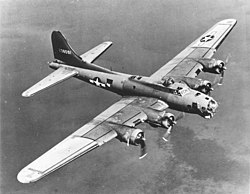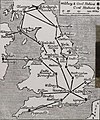Portal:Aviation
| Main page | Categories & Main topics |
|
Tasks and Projects |
The Aviation Portal

Aviation includes the activities surrounding mechanical flight and the aircraft industry. Aircraft includes fixed-wing and rotary-wing types, morphable wings, wing-less lifting bodies, as well as lighter-than-air aircraft such as hot air balloons and airships.
Aviation began in the 18th century with the development of the hot air balloon, an apparatus capable of atmospheric displacement through buoyancy. Some of the most significant advancements in aviation technology came with the controlled gliding flying of Otto Lilienthal in 1896; then a large step in significance came with the construction of the first powered airplane by the Wright brothers in the early 1900s. Since that time, aviation has been technologically revolutionized by the introduction of the jet which permitted a major form of transport throughout the world. (Full article...)
Selected article
Selected image

Did you know
...that Astro Flight, Incorporated of Marina del Rey, California created the world's first practical electric-powered radio controlled model airplane and the world's first full-scale solar-powered airplane? ...that during World War II, Marine Fighting Squadron 215 established four new U.S. Marine Corps records in the South Pacific including having the most ace pilots? ... that Soviet test pilot Vladimir Kokkinaki set twenty aviation world records?
General images -
In the news
- May 29: Austrian Airlines cancels Moscow-bound flight after Russia refuses a reroute outside Belarusian airspace
- August 8: Passenger flight crashes upon landing at Calicut airport in India
- June 4: Power firm helicopter strikes cables, crashes near Fairfield, California
- January 29: Former basketball player Kobe Bryant dies in helicopter crash, aged 41
- January 13: Iran admits downing Ukrainian jet, cites 'human error'
- January 10: Fire erupts in parking structure at Sola Airport, Norway
- October 27: US announces restrictions on flying to Cuba
- October 3: World War II era plane crashes in Connecticut, US, killing at least seven
- September 10: Nevada prop plane crash near Las Vegas leaves two dead, three injured
- August 6: French inventor Franky Zapata successfully crosses English Channel on jet-powered hoverboard
Related portals
Associated Wikimedia
The following Wikimedia Foundation sister projects provide more on this subject:
-
Commons
Free media repository -
Wikibooks
Free textbooks and manuals -
Wikidata
Free knowledge base -
Wikinews
Free-content news -
Wikiquote
Collection of quotations -
Wikisource
Free-content library -
Wikiversity
Free learning tools -
Wikivoyage
Free travel guide -
Wiktionary
Dictionary and thesaurus
Selected biography
Ballooning was a risky business for the pioneers. Blanchard lost consciousness on a few occasions, endured freezing temperatures and almost drowned when her balloon crashed in a marsh. In 1819, she became the first woman to be killed in an aviation accident when, during an exhibition in the Tivoli Gardens in Paris, she launched fireworks that ignited the gas in her balloon. Her craft crashed on the roof of a house and she fell to her death. She is commonly referred to as Madame Blanchard and is also known by many combinations of her maiden and married names, including Madeleine-Sophie Blanchard, Marie Madeleine-Sophie Blanchard, Marie Sophie Armant and Madeleine-Sophie Armant Blanchard.
Selected Aircraft

The Boeing B-17 Flying Fortress is an American four-engine heavy bomber aircraft developed for the U.S. Army Air Corps (USAAC). Competing against Douglas and Martin for a contract to build 200 planes, the airplane outperformed both the other entries and the Air Corps' expectations. Although losing the contract due to an accident, the Air Corps was so in favor of the B-17 that they ordered 13 B-17s regardless. Evolving through numerous design stages, from B-17A to G, the Flying Fortress is considered the first truly mass-produced large aircraft. From its pre-war inception, the USAAC touted the aircraft as a strategic weapon; it was a high-flying, long-ranging potent bomber capable of defending itself. With the ability to return home despite extensive battle damage, its durability, especially in belly-landings and ditchings, quickly took on mythical proportions.
The B-17 was primarily involved in the daylight precision strategic bombing campaign of World War II against German industrial targets. The United States Eighth Air Force based in England and the Fifteenth Air Force based in Italy complemented the RAF Bomber Command's night-time area bombing in Operation Pointblank, which helped secure air superiority over the cities, factories and battlefields of Western Europe in preparation for Operation Overlord. The B-17 also participated, to a lesser extent, in the War in the Pacific.
Today in Aviation
- 2009 – The European Commission extends its blacklist to cover all airlines based in Djibouti, the Republic of the Congo and São Tomé. In Ukraine, Ukrainian Cargo Airways and Volare Airlines were removed from the blacklist as their Air Operator’s Certificates had been revoked. Motor Sich Airlines were also removed from the blacklist and Ukrainian Mediterranean Airlines were allowed to operate a single aircraft. TAAG Angola Airlines was allowed to increase the number of aircraft used for flights to Portugal.
- 2009 – A Sri Lanka Air Force Mil Mi-24 Hind Helicopter (CH635, c/n 3532431622597) engaged on a training mission, crashed 5 km north of Buttala(310 km south-east of Colombo) at approximately 1330 HRS due to technical failure. Prior to the crash the pilot have reported a power generator failure to the tail rotor. Pilot, Co-Pilot and 2 door gunners have died from this incident.
- 2008 – XL Airways Germany Flight 888 T was an Airbus A320 which was seen to plunge into the Mediterranean Sea, 7 km off Saint-Cyprien on the French coast, close to the Spanish border. Seven people were aboard, two Germans (pilot and co-pilot from XL Airways) and five New Zealanders (one pilot, three aircraft engineers and one member of the Civil Aviation Authority of New Zealand). Two bodies were recovered within hours of the crash; the others were found during later weeks.
- 2006 – F-16CG, serial 90-0776, from the 524th Fighter Squadron crashes near Fallujah while on a low-altitude ground-strafing run. The pilot, Major Troy Gilbert, was killed. His body was taken by insurgents. It was never recovered.[1][2]
- 1989 – 1989 Jamba Hercules crash refers to an acicdent involving a Lockheed Hercules C-100 aircraft belonging to a CIA front company, Tepper Aviation, that crashed on final approach at Jamba, Huíla in Angola while delivering arms to UNITA.
- 1989 – Avianca Flight 203, a Boeing 727, explodes in mid-air over Colombia, killing all 107 people on board and three people on the ground. The Medellín Cartel claimed responsibility for the attack.
- 1975 – The announcement that Canada to was purchase 18 P-3 s as long range patrol aircraft was to be known as CP-140 Auroras in the Canadian Forces.
- 1964 – A Lockheed SP-2H Neptune, BuNo 135610, c/n 726-7046, "YC 12", of VP-2, out of NAS Kodiak, crashes into a mountain near the tip of Cape Newenham, Alaska. Twelve crew members killed.
- 1956 – Linea Aeropostal Flight 253, a Lockheed L-749 Constellation, crashes while on approach to Caracas International Airport, killing all 25 on board.
- 1952 – James D. Wetherbee, American astronaut, was born. Wetherbee is a veteran of six space shuttle missions, and is the only American to have commanded five missions.
- 1951 – French Leduc 0.22-01 ramjet-powered prototype interceptor is badly damaged in landing accident and the pilot seriously injured.
- 1949 – First flight of the Douglas C-124 Globemaster II
- 1945 – Douglas C-47B Skytrain, 43-16261,[84] of Air Transport Command, piloted by 1st Lt. William H. Myers, disappears during flight from Singapore to Butterworth, British Malaya. Wreckage found on mountain slope in the forest reserve area of Bukit Bubu, near Beruas, Perak, Malaysia. Crew remains never recovered.
- 1944 – In one mission, Captain Charles E. "Chuck" Yeager shoots down four German FW-190s.
- 1944 – During a 3,000-mile out-and-back navigation training mission from Great Bend Army Airfield Great Bend Army Airfield, Kansas, to Batista Army Airfield, Cuba, Boeing B-29-25-BW Superfortress, 42-24447, coded '35', of the 28th Bombardment Squadron (Very Heavy), 19th Bombardment Group (Very Heavy), suffers fire in number 1 (port outer) engine. Aircraft commander, 1st Lt. Eugene Hammond, orders crew bail-out 37 miles S of Biloxi, Mississippi. After all but pilot have departed, the burning engine nacelle drops off of the wing, Lt. Hammond returns to controls, brings the bomber into Keesler Field, Mississippi for emergency landing. Only four recovered from the Gulf of Mexico, one dead, three injured
- 1944 – First flight of the Boeing XF8B
- 1944 – Three Japanese transport aircraft carrying demolition troops attempt to land troops at Buri airfield on Leyte and on the Leyte invasion beachhead via crash landings, but many of the troops are killed in the crashes and the survivors do little damage.
- 1944 – Japanese aircraft staging through Iwo Jima make their first successful strikes against U. S. B-29 s on Saipan. An early raid by two twin-engined bombers destroys a B-29 and damages 11 others, while later in the day 10 to 15 single-engined fighters attack, destroying three B-29 s and damaging two.
- 1944 – Japanese kamikazes damage the battleship USS Colorado (BB-45) and light cruiser USS St. Louis (CL-49) in Leyte Gulf.
- 1944 – 81 B-29 s attempt a second attack on the Musashino aircraft plant in Tokyo. Heavy cloud cover forces them to bomb secondary targets instead.
- 1942 – Douglas O-46A, 35-179, of the 81st Air Base Squadron, piloted by Gordon H. Fleisch, lands downwind at Brooks Field, Harlingen, Texas, runs out of runway, overturns. Written off, it is abandoned in place. More than twenty years later it is discovered by the Antique Airplane Association with trees growing through its wings, and in 1967 it is rescued and hauled to Ottumwa, Iowa. Restoration turns out to beyond the organization's capability, and in September 1970 it is traded to the National Museum of the United States Air Force for a flyable C-47. The (then) Air Force Museum has it restored at Purdue University and places it on display in 1974, the sole survivor of the 91 O-46s built.
- 1941 – No. 417 (Fighter) Squadron was formed in England.
- 1940 – During the Battle of Cape Spartivento, the Italian naval commander Admiral Inigo Campioni orders his fleet to retire upon receiving word of the strength of the opposing British force. A torpedo strike by 11 Swordfish against his fleeing ships is ineffective, as is a belated attack on the British aircraft carrier HMS Ark Royal by Italian high-level bombers.
- 1939 – Longest ambulance flight in Canadian history was carried out by a Junkers W-34 of Canadian Airways, piloted by WE Catton from Winnipeg Manitoba, to Repulse Bay, NWT and return.
- 1929 – 27-28 – Richard Byrd and crew make the first flight over the South Pole in a Ford Trimotor.
- 1923 – The Douglas Co. is awarded a $192,684 contract by the War Department to build four DWC aircraft and spares.
- 1912 – The aeronautical division of the US Army Signal Corps receives the first “flying boat”, a Curtiss Model F, capable of takeoff from water.
References
- ^ "US F-16 goes down in Iraq". Al Jazeera. 2006-11-27. Retrieved 2007-12-21.
- ^ http://www.khou.com/news/texas-news/Plea-by-family-of-fallen-Texas-airman-reaches-the-Pentagon-139990933.html
http://www.chuckyeager.com/four-victory-fw-190-report
- Shortcuts to this page: Portal:Airplanes • P:AVIA





















































